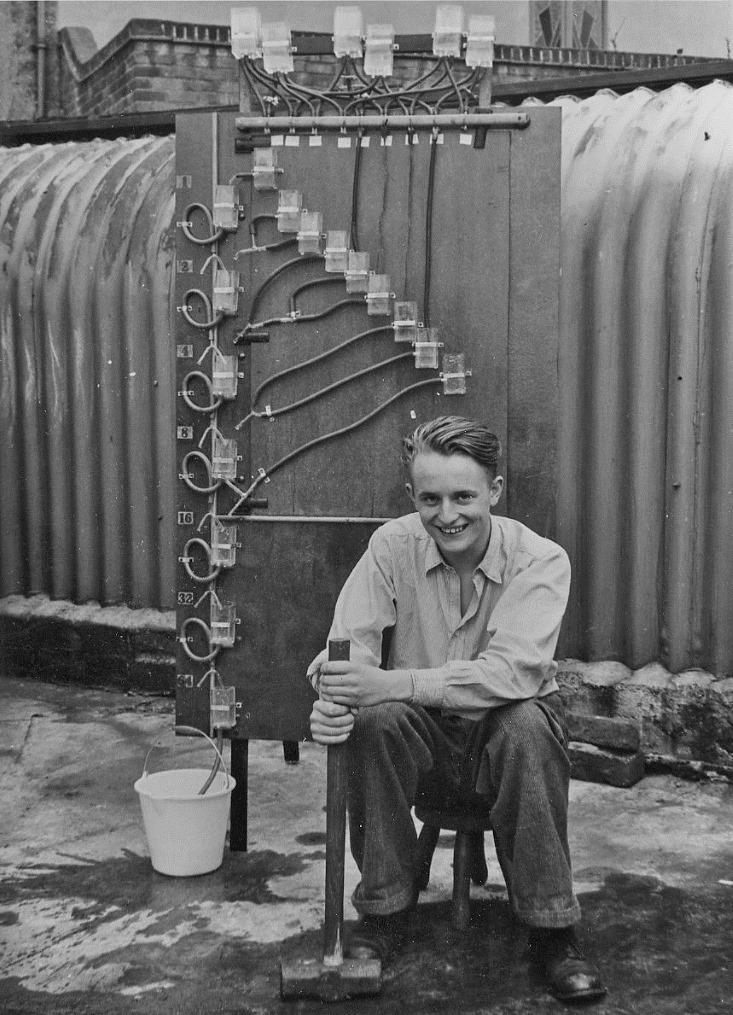John Horton Conway, a Fellow of the Royal Society who hails from Princeton via Cambridge, England, is notorious for many things—perhaps most for his promiscuous curiosity and his lifelong love affair with playing all manner of games.
He’s also celebrated for his Conway groups in mathematical symmetry, for his surreal numbers, and for inventing cellular automaton Game of Life—though he’s gone off that game lately. He opened a talk at an artificial intelligence conference in New York City last summer with the booming confession: I HATE LIFE!
The Game of Life, which Conway invented circa 1970, was not his first foray into the realm of computer science, as it were. During his undergraduate career at Cambridge, he tinkered with what one might call artisanal computers. Conway and his friend Mike Guy engineered a computer using knotted embroidery string, and another using marbles. And then Conway unveiled his water computer.
In October 1957, Conway and a few of his chums walked along the cobblestoned Trinity Street in Cambridge and put up posters announcing:
WINNIE is coming!
The posters went up along King’s Parade, Trumpington Street, the fence around Great St. Mary’s Church, and scattershot about town:
WINNIE is waiting for you …
Watch out for WINNIE!
Are you ready for WINNIE?
This was two decades or so after Alan Turing booted up the computer age with his Automatic Computing Engine, aka ACE, and from there the computer’s lineage degenerates into a tangled timeline of acronyms: ENIAC, EDVAC, EDSAC, MANIAC.
Conway contributed WINNIE, a “Water Initiated Numerical Number Integrating Engine.” Though it’s unlikely it was “Numerical Number.” More likely, “Water Initiated Nonchalantly Numerical Integrating Engine,” or some such.

Designed based on Conway’s close observation of urinal-flushing mechanics, WINNIE, standing six feet tall, was engineered from plastic cups, siphons, and circuitous plumbing. But best to let the mad scientist explain himself:
How it worked was this: Standing on the stool, I’d pour 1 unit of water into the cup at the very top. This cup would then be ½ full, and the water would just stay in there, and that indicated the binary notation “1” and registered the numerical value 1.
Then I’d pour in another unit of water into the same cup, filling it up and causing all the water to run out via a little tube halfway up at the side of the cup—that’s how a siphon works, when the water starts moving out all of it flows out, and it would all runneth over, ½ of it going into the cup waiting below, indicating now the binary notation “10,” for the numerical value 2. Pour in another unit, and the first cup again registered “1” and the second still holds “1,” which gives us a grand total of “11,” or 3. Another unit made the first 2 cups empty with the third cup registering “1,” giving 4. And so on. WINNIE could count to 127, or 64 + 32 + 16 + 8 + 4 + 2 + 1, or 1111111.
She could also add and multiply. Though as soon as the product of any calculation exceeded her limit, she started peeing—and in fact she peed off ½ a cup when any cup received its second allotment and ran over to the next cup, that was the operating principle. But the peeing happened en masse at the end. All at once all the cups would runneth over in a domino effect waterfall, emptying all the cups and clearing all the reservoirs to 0 as all the water flushed into a holding tank on the floor. At least that was where the water was supposed to go.
There was an unfortunate incident when Conway exhibited WINNIE at the Societies’ Fair, the annual fall fair where Cambridge University clubs showed off their wares in the hopes of recruiting new members. Conway belonged to two clubs: the Archimedeans, the university math club, and the New Pythagoreans, the math club associated with his college as well as about five other colleges, including Girton, a women’s college (there were four women’s colleges in Cambridge at the time).
That’s important, the girls. We had to pull in some girls!
Conway and his water computer represented the Archimedeans at the fair, though the unfortunate thing was that WINNIE peed and caused a flood and destroyed a nice piece of the Guildhall’s parquet flooring. The Societies Fair was thereafter held elsewhere, in the Corn Exchange. Nonetheless, WINNIE was a popular exhibit, earning a write-up in the Cambridge newspaper. She was a “proof of principle” experiment, an experiment conducted to see if Conway’s harebrained idea was workable.
Hypothesis: If a urinal-flushing doohickey is properly repurposed, it will power a binary computer.
Conclusion: Yes indeed, it will.
This piece is excerpted from Siobhan Roberts’ new book—Genius at Play: The Curious Mind of John Horton Conway—which is out on July 14.






























